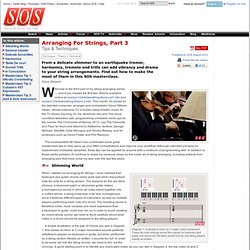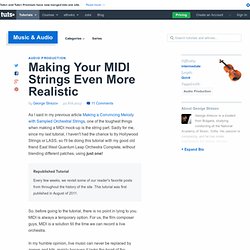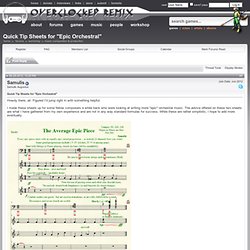

Breaking the Ostinato habit- Help with compostitoin - Composers' Forum. Www.guitarmasterclass.net/guitar_forum/index.php?act=attach&type=post&id=21833. Arranging For Strings, Part 3. From a delicate shimmer to an earthquake tremor, harmonics, tremolo and trills can add vibrancy and drama to your string arrangements.

Find out how to make the most of them in this SOS masterclass. Dave Stewart Welcome to the third part of my string-arranging series — and if you missed the first two, they're available online at /sos/jun12/articles/string-theory-pt1.htm and /sos/jul12/articles/string-theory-2.htm. This month, I'm joined by the talented composer, arranger and orchestrator David William Hearn, whose extensive CV includes (deep breath) music for the TV shows Dancing On Ice, American Idol and The Voice, countless television ads, programming orchestral mock-ups for the movies The Chronicles of Narnia, 2012, Lay The Favourite and Paul, for tours and albums by Katherine Jenkins, George Michael, Westlife, Kylie Minogue and Shirley Bassey, and for producers such as David Foster and Phil Ramone.
Making Your MIDI Strings Even More Realistic. As I said in my previous article Making a Convincing Melody with Sampled Orchestral Strings, one of the toughest things when making a MIDI mock-up is the string part.

Sadly for me, since my last tutorial, I haven't had the chance to try Hollywood Strings or LASS, so I'll be doing this tutorial with my good old friend East West Quantum Leap Orchestra Complete, without blending different patches, using just one! Republished Tutorial Every few weeks, we revisit some of our reader's favorite posts from throughout the history of the site. This tutorial was first published in August of 2011. So, before going to the tutorial, there is no point in lying to you. In my humble opinion, live music can never be replaced by zeroes and bits, mainly because it lacks the heart of the musician. How to Create a Compelling Ostinato. The ostinato pattern is a staple of modern music; across every genre you'll find countless examples of pieces that at their core revolve around a single repeating ostinato pattern.

In this tutorial we'll look at how to create an ostinato pattern from a simple outline, give it a unique and intriguing sound, and use this pattern as a basic building block for creating your own original compositions. Twice a month we revisit some of our reader favorite posts from throughout the history of Audiotuts+. This tutorial was first published in September 2008. Although everyone has their own method of working, when I write a piece from an ostinato ground up my first priority is often to choose my foundation instrument. The right color choice can often act as your guide and spark your creativity when faced with the ever intimidating blank screen when you first get to work. For this example I've chosen an acoustic guitar harmonics patch. Creating the musical element is really quite simple.
Basic melody. Getting to Know Altered Chords Part 4: Altered III. In this series we will learn about altered chords and how we can use them to add harmonic interest to our music.

Part 4 of the series will continue with the altered III chord. The Altered Chord Series This is the fourth article in a seven part series on altered chords. In the first part I explained that by lowering or raising a tone of a chord by a half step you can change the color and function of a chord. Part 1 looked at altered V chords, Part 2 at altered II chords, and Part 3 at altered VI chords. Diatonic iii The third diatonic chord in a major key is a minor 7th chord.
Arranging for Strings - Tuts+ Music & Audio Tutorials. Getting to Know Altered Chords Part 1: Altered V. We always get a lot of comments when we ask about music theory tuts.

5 Orchestration Lessons from John Williams' Flight to Neverland - Composer Focus. For many young film composers, including myself, John Williams is the guy when it comes to orchestral film music. His scores are lush, complex and exciting. Although we all strive to have a unique voice in our music, there is plenty to be learned by taking a close look at the techniques Williams uses to achieve his orchestral sound. In this article I’ll discuss five observations on the orchestration from the piece “Flight to Neverland”, from his score to Hook.
This article is by no means comprehensive, but there are some valuable lessons that typical orchestration books (95% of which should be relabeled “instrumentation” books) wont teach you. You can purchase and download an mp3 of the piece from Amazon here , and if you’re willing to pay a premium price you can even purchase a copy of the full score . Combinations. Combinations of instruments from different sections of the orchestra is really the essence of orchestration.

Since most orchestral music is the result of such combinations, there is an enormous variety of possibilities which have by no means been exhausted. This page sets out to give some typical examples. Use the links on the left to sample various examples of combination scoring from the Philharmonia's recorded archive. Melody_fragments photo by Imparus. Quick Tip Sheets for "Epic Orchestral" - OverClocked ReMix Forums. Perhaps you should try a Piano Roll.

It's all MIDI, and generally you just click in notes with a mouse instead of playing it in real time. Epic_piece.png photo by Imparus.